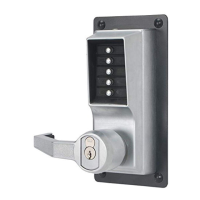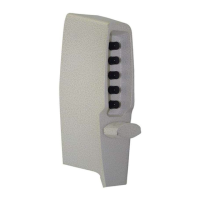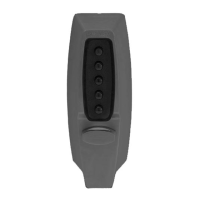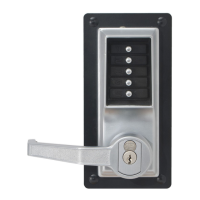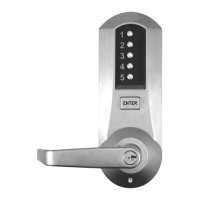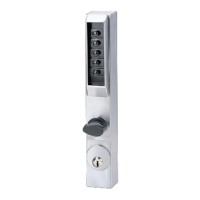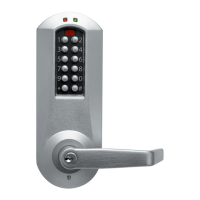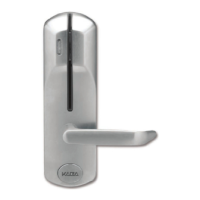La relación entre puerta y marco es crítica
para el rendimiento y durabilidad del
mecanismo del pestillo. Al colocar la
cerradura, la contra y el pestillo, las líneas
centrales, verticales y horizontales, son
importantes y deben cumplir con la norma
ANSI* A115.2. $4$$5(*74$470$
,056$.$&,@0$'(&7$'$756(''(%(4<
75$4.$2.$&$'(&1064$37(8,(0(&10.$
&(44$'74$
Para alinear adecuadamente la puerta
quizá se requieren topes de caucho (pro-
vistos con la cerradura). El ajuste se hace
más importante en los casos de marcos
de metal, puertas de madera, y placas de
relleno cuando se cambian los herrajes
existentes. La ilustración 17-1 muestra la
alineación adecuada entre la puerta, el
marco, el pestillo y la placa de la contra.
Cuando la puerta se apoya contra el tope
(A), el saliente del pestillo (B) debería apo-
yarse contra la placa de contra. Aquí
notará una tolerancia de
3
⁄3
2
pulg. (2 mm),
básica según las normas ANSI. Si la puer-
ta gira más allá de esta tolerancia, el pin
de seguridad puede deslizarse en la caja
de la contra con el dispositivo de antifric-
ción, haciendo que se atasque creando un
bloqueo (Véase la ilustración 17-2).
Esta situación puede prevenirse añadien-
do otros topes a los topes de la puerta.
* Instituto Nacional Estadounidense de
Normas — para más información sírvase
entrar en contacto con KABA ILCO.
The door to frame relationship is critical for
the performance and durability of the latch
mechanism. The vertical and horizontal
center lines are important when positioning
the lock, the strike, and the latch, and must
be according to ANSI* standard A115.2.
(<6;@B?2=?<=2?6;@A.99.A6<;F<B:B@A
B@2A52@B==9621@A?682=9.A2
Rubber bumpers (supplied with the lock)
may be required to properly align the door.
The adjustment becomes more significant
with metal frames, wood doors, and filler
plates when replacing existing hardware.
Figure 17-1 shows the proper alignment
between the door, the frame, the latch and
the strike plate.
When the door rests against the door stop
(A), the dead latch (B) should seat against
the strike plate. At this point, you will notice
a tolerance of
3
⁄32" (2 mm), basic according to
ANSI standards. If the door travels beyond
this tolerance, the dead latch may slip into
the strike box with the anti-friction device,
causing the latch to jam, and create a
lock-in and lock-out condition (see
A in figure 17-2).
This condition can be prevented by adding
bumpers to the door stop.
* American National Standards Institute —
contact KABA ILCO for further information.
%?2@2?C6;4A529.A05
$06(0,/,(061'(.2(56,..1
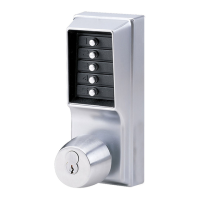
